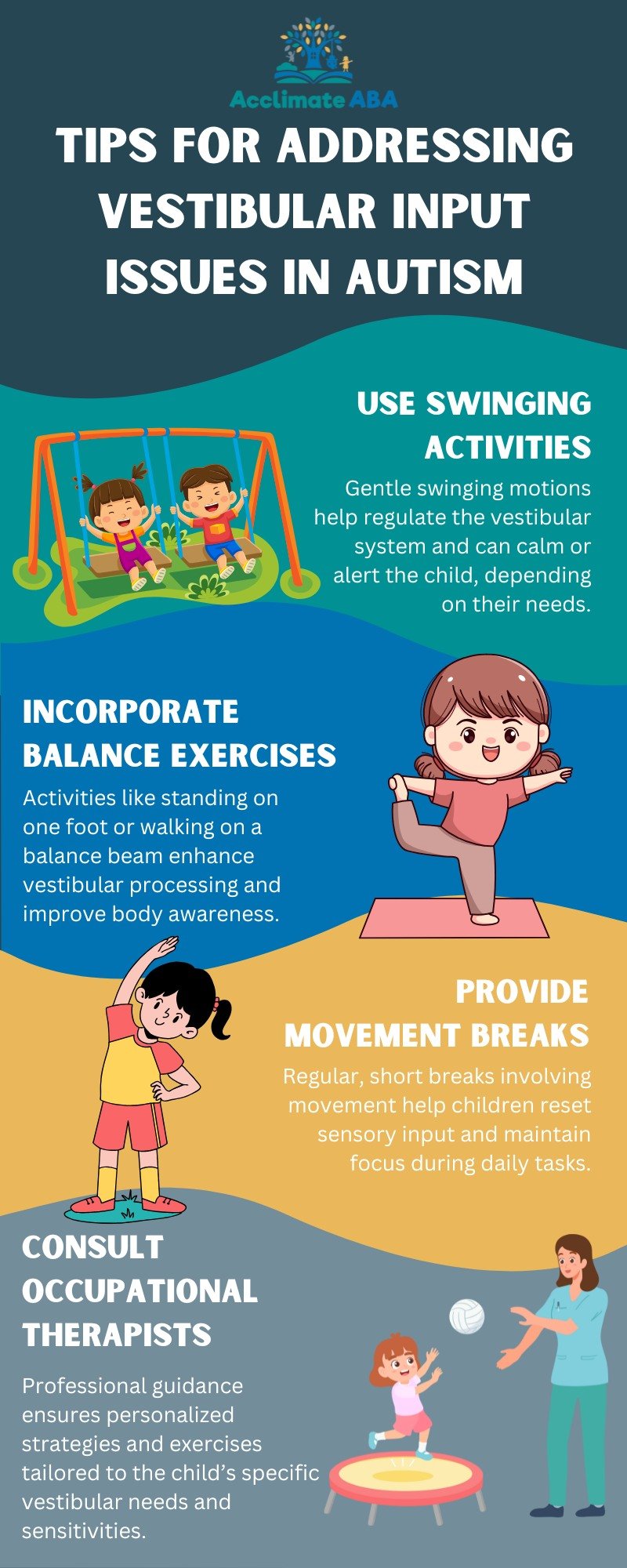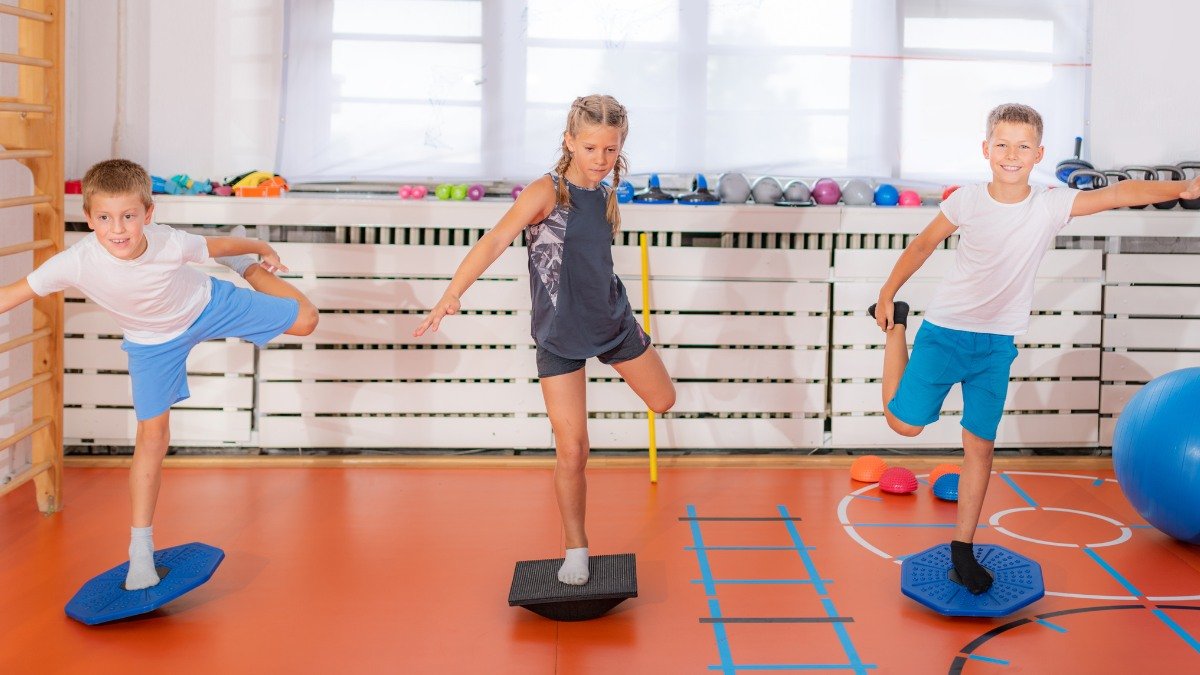Key Points:
- Vestibular input refers to sensory information related to balance and movement.
- Individuals with autism often experience differences in sensory processing, including how they respond to vestibular input.
- Properly addressing vestibular needs can improve behavior, focus, and overall well-being for individuals with autism.
Studies indicate that approximately 90% of individuals with autism also experience some form of sensory processing disorder. Sensory processing involves how the brain receives and interprets input from the environment, and it significantly affects behavior and emotional regulation.
One of the key sensory systems is the vestibular system, which controls balance, coordination, and movement. For individuals with autism, the way they respond to vestibular input and autism can differ greatly from others. Some may seek out certain types of movement, while others may avoid it entirely.
This article dives into how vestibular input influences individuals with autism and offers insight into strategies for managing sensory processing challenges.
What is Vestibular Input?
Vestibular input refers to the sensory information your body receives from movement and balance. This input is processed through the vestibular system, located in the inner ear, which helps the body maintain a sense of balance and spatial orientation. The system is responsible for detecting motion and changes in position, such as when you tilt your head, spin, or move in space.
When the brain processes vestibular input correctly, it helps you maintain coordination, balance, and the ability to orient yourself in your surroundings. In people without sensory processing challenges, this system typically works automatically. However, for many individuals with autism, processing vestibular input can be a source of difficulty.
How Does Vestibular Input Affect Autism?
For individuals with autism, the vestibular system may be over-responsive, under-responsive, or even both at different times. This can affect how they engage with the world around them. For example, some children with autism may become overwhelmed by certain types of movement, such as swinging or spinning, while others may crave intense vestibular input and seek out sensory activities like spinning or jumping to regulate their sensory experiences.
Sensory processing dysfunctions, including issues with vestibular input, are common in individuals with autism. This dysfunction can manifest in a variety of ways, including:
- Under-responsiveness: This may lead to seeking out intense motion and activity, like spinning, rocking, or swinging.
- Over-responsiveness: Individuals may become distressed by certain movements or experiences, such as riding in a car, being on a swing, or feeling dizzy.
The impact of vestibular dysfunction can vary greatly from person to person, which makes understanding these sensory differences essential for supporting individuals with autism.
Why is Vestibular Input Important for Autism?
Vestibular input is a key part of sensory processing that affects many areas of life, including behavior, attention, and overall regulation. When the vestibular system is out of balance—whether under-responsive or over-responsive—it can lead to difficulties with focus, anxiety, and even physical coordination. Addressing these sensory needs is crucial for individuals with autism, as the right types of vestibular input can help improve self-regulation and emotional stability.
Positive Impact of Proper Vestibular Input
When individuals with autism receive the right amount of vestibular input, they are better able to regulate themselves, improving both their physical and emotional well-being. In some cases, vestibular activities can help improve focus, reduce anxiety, and even lead to better motor coordination.
For example, individuals who are under-responsive to vestibular input may benefit from activities such as jumping on a trampoline, swinging, or spinning in a controlled environment to provide sensory input and help them feel more grounded. On the other hand, children who are over-responsive may find relief in activities that provide calming, slow movements, like gentle rocking or swaddling.
How Vestibular Input Affects Daily Functioning
Vestibular input also plays a crucial role in daily functioning. The ability to stay balanced, coordinate movements, and understand where the body is in space is fundamental to tasks such as walking, running, and even sitting still. By supporting individuals with autism in processing vestibular input, it becomes easier for them to engage in everyday activities like:
- Participating in school or play activities
- Navigating social situations
- Performing self-care tasks (like brushing teeth or tying shoes)
Understanding the role of vestibular input and how it connects to autism is crucial for parents, educators, and therapists working with individuals on the spectrum, especially as they seek tools to create more supportive and inclusive environments—both offline and online. For insights on enhancing communication and safety in digital spaces, check out our article Making Social Media Safer with Tone Tags for Autism.
6 Common Signs of Vestibular Processing Issues in Autism
Understanding how to identify vestibular processing issues can help parents and caregivers intervene early. Signs of sensory difficulties related to the vestibular system may vary widely. Some individuals may exhibit behaviors indicating that they are either seeking more sensory input or trying to avoid it.
Signs of Under-Responsiveness to Vestibular Input
- Craving movement and sensory input, such as constantly spinning, rocking, or jumping.
- A preference for fast-paced or intense movement, like swinging or roller coasters.
- Lack of awareness of the body’s position in space, which may lead to clumsiness or difficulty with coordination.
Signs of Over-Responsiveness to Vestibular Input
- Avoidance of activities that involve movement or balance, such as swings or rides.
- A heightened fear of falling or getting dizzy.
- Difficulty handling changes in position, like tilting the head back or lying down.
These behaviors can create challenges in daily life, from classroom activities to social interactions. Recognizing the signs and providing appropriate sensory interventions can make a big difference in a child’s ability to cope with the world around them.
Can Vestibular Input Issues in Autism be Corrected?
Vestibular input issues in autism may not be fully “corrected,” but they can be effectively managed and improved with the right support. Occupational therapy with sensory integration techniques helps children become more comfortable with movement and body awareness.
In addition, ABA therapy can play a key role by reinforcing positive responses to vestibular activities and reducing avoidance behaviors. Therapists may use structured reinforcement and gradual exposure to help children tolerate and engage in movement-based tasks. With consistent intervention, many children show meaningful progress in balance, coordination, and daily functioning.
How to Address Vestibular Input Issues in Autism
Children with autism often experience challenges processing vestibular input, which affects balance and spatial orientation. Addressing these issues can improve coordination and reduce anxiety. Here are practical strategies parents and caregivers can use:
 Support Your Child’s Development with ABA Therapy
Support Your Child’s Development with ABA Therapy
Acclimate ABA provides comprehensive ABA therapy in Utah, specializing in helping individuals with autism process sensory input, including vestibular input, in a positive and supportive environment. Through individualized therapy sessions, we help children and families develop coping strategies for sensory processing challenges.
If you’re looking for ABA therapy in Utah, reach out to us to learn more about how our therapists can help your child with autism navigate sensory processing challenges, including those related to vestibular input. Our team works to create customized strategies that support both emotional and physical development, ensuring your child can thrive!


